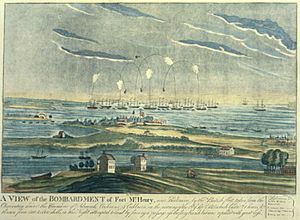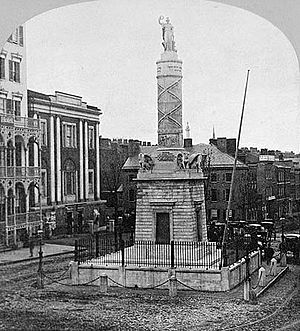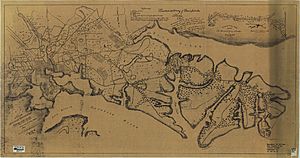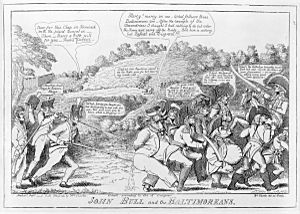Battle of Baltimore facts for kids
Quick facts for kids Battle of Baltimore |
|||||||
|---|---|---|---|---|---|---|---|
| Part of the War of 1812 | |||||||
 Bombardment of Fort McHenry by the British. Engraved by John Bower |
|||||||
|
|||||||
| Belligerents | |||||||
| Commanders and leaders | |||||||
| Strength | |||||||
| North Point: 3,000 infantry, militia Hampstead Hill 10,000 regulars 2,000-5000 infantry militia, 100+ Guns Fort McHenry: 1,000 infantry milita 20 artillery pieces Additional Defense: 8,000 militia 150 artillery pieces Total: 22,000-25,000 |
Land: 5,000 infantry Sea: 19 warships |
||||||
| Casualties and losses | |||||||
| North Point & Hampstead Hill: 24 killed, 139 wounded, 50 captured Fort McHenry: 4 killed, 24 wounded Total: 28 killed, 163 wounded, 50 captured |
North Point & Hampstead Hill: 39–46 killed, 251–295 wounded Fort McHenry: 1 wounded Total: 39–46 killed, 252–296 wounded |
||||||
The Battle of Baltimore (September 12 – 15, 1814) was a big fight on land and sea. It happened between British invaders and American defenders during the War of 1812. American forces stopped the British from taking the important port city of Baltimore, Maryland. They even killed the British commander.
The first part of the battle was at Battle of North Point. The Americans had to fall back, but they fought hard. This slowed the British down and gave Baltimore's defenders time to get ready.
The strong defense of Baltimore's Fort McHenry against the Royal Navy was very inspiring. It made Francis Scott Key write a poem called "Defence of Fort McHenry." This poem later became the words to "The Star-Spangled Banner," which is now the national anthem of the United States.
Did you know? A future US President, James Buchanan, was a soldier helping to defend Baltimore in this battle.
Contents
Why Did the Battle of Baltimore Happen?
Until April 1814, Britain was busy fighting Napoleon in Europe. This meant they didn't focus much on the war in America. The British mostly tried to defend their lands in Canada.
However, things changed after Napoleon was defeated. Britain could send more soldiers to America. They wanted to force the United States to make peace. Many experienced British soldiers came from Europe.
Some of these soldiers, led by Major General Robert Ross, were sent to attack American cities. They hoped this would make the Americans pull their troops away from Canada.
The British Attack Washington, D.C.
The British decided to attack important American cities. One big target was Washington, the capital city. They thought it would be easy to capture.
On August 24, 1814, British troops marched into Washington. They captured the city with about 4,500 experienced soldiers. General Ross ordered them to burn public buildings. This included the White House and the United States Capitol.
After burning Washington, the British went back to their ships. They then turned their attention to Baltimore.
Why Baltimore Was a Target
Baltimore was a very busy port city. The British believed many American privateers (ships that attacked British trading vessels) were based there. They wanted to hit Baltimore hard to hurt American morale.
The British planned a two-part attack on Baltimore. General Ross would lead a land attack at North Point. Meanwhile, Vice-Admiral Sir Alexander Cochrane would attack Fort McHenry by sea. Fort McHenry protected Baltimore Harbor.
Baltimore's defenses were already being prepared. Major General Samuel Smith of the Maryland Militia was in charge of getting the city ready.
Who Fought in the Battle?
American Forces
The American forces were led by Major General Samuel Smith. He commanded the Maryland Militia. Other important leaders included Brigadier General John Stricker and Major George Armistead.
The Americans had many different groups of fighters. These included regular U.S. Army soldiers, local militia (citizen soldiers), and U.S. Navy sailors. They also had artillery (cannons) to defend the city.
British Forces
The British forces were led by Vice Admiral Alexander Cochrane for the navy. Major General Robert Ross led the land troops.
The British had a strong navy with many warships. They also had about 5,000 soldiers for the land attack. These soldiers were very experienced from fighting in Europe.
The Battle Begins
The Fight at North Point
On September 12, the British landed about 5,000 troops. They started marching towards Baltimore. They first met strong American resistance at the Battle of North Point. This battle happened about 5 miles (8 km) from the city.
General Smith sent about 3,000 men, led by General John Stricker, to meet the British. Their job was to slow down the British. This would give General Smith more time to finish Baltimore's defenses.
During this fight, the British land commander, General Ross, was killed. He was shot by an American sharpshooter. After Ross died, Colonel Arthur Brooke took command of the British army.
The Americans then began to fall back in an organized way. They went to the main defenses of Baltimore to wait for the British attack.
Defending Hampstead Hill
The main defense line for Baltimore was at Hampstead Hill. This area is now part of Patterson Park. It had strong earthworks (dirt walls) and over 100 cannons.
On September 13, the British troops advanced towards Baltimore. They forced the American troops to retreat to the main defense line. The British commander, Colonel Brooke, saw how strong the American defenses were.
The American line was defended by over 10,000 regular troops and thousands of local militia. The defenses were much stronger than the British expected. The British tried to attack but failed.
After talking with his officers, Brooke decided not to risk a direct attack. He ordered his troops to return to their ships early on September 14.
The Attack on Fort McHenry
At Fort McHenry, about 1,000 soldiers waited for the British naval attack. Major George Armistead was in charge of the fort. To make it harder for British ships to pass, the Americans sank some of their own merchant ships at the harbor entrance.
The British naval attack started on September 13. A fleet of about 19 British ships began firing rockets and mortar shells at the fort. After a short exchange of fire, the British ships moved out of range of the fort's cannons. They continued to bombard the fort for the next 25 hours.
The British fired between 1,500 and 1,800 cannonballs at the fort. But the damage was light because the fort had been recently strengthened.
On the morning of September 14, the large American flag was raised over Fort McHenry. This flag was 30 by 42 feet (9.1 by 12.8 meters). It had been made a year earlier by Mary Young Pickersgill and her daughter. This flag was usually raised every morning.
Because the fort's defenses were so strong, the British commander, Brooke, decided to withdraw. He had orders not to attack if there were more than 2,000 men in the fort. The British troops returned to their ships. The fleet then sailed away, heading for New Orleans.
What Happened After the Battle?

Colonel Brooke's troops left Baltimore. Admiral Cochrane's fleet sailed off to prepare for their next attack, which would be at the Battle of New Orleans.
Major Armistead, who commanded Fort McHenry, was promoted to lieutenant colonel. Sadly, he died three years later at age 38, likely due to the stress of preparing for the battle.
Today, the Fort McHenry National Monument and Historic Shrine remembers this important battle.
The Star-Spangled Banner
An American lawyer and poet named Francis Scott Key was on a British ship during the battle. He was there to help release an American prisoner, Dr. William Beanes. The British agreed to release Dr. Beanes, but Key and Beanes had to stay on the ship until the battle was over.
Key watched the battle from the ship in the Patapsco River. On the morning of September 14, he saw the American flag still waving over Fort McHenry. This sight filled him with inspiration. He started writing a poem on the back of a letter.
Key's poem was first called "Defence on Fort McHenry." It was printed on papers by the Baltimore American.
Later, Key's poem was set to the music of a British song called "To Anacreon in Heaven." The song became known as "The Star-Spangled Banner." In 1931, the U.S. Congress officially made it the national anthem of the United States.
See also
 In Spanish: Batalla de Baltimore para niños
In Spanish: Batalla de Baltimore para niños




